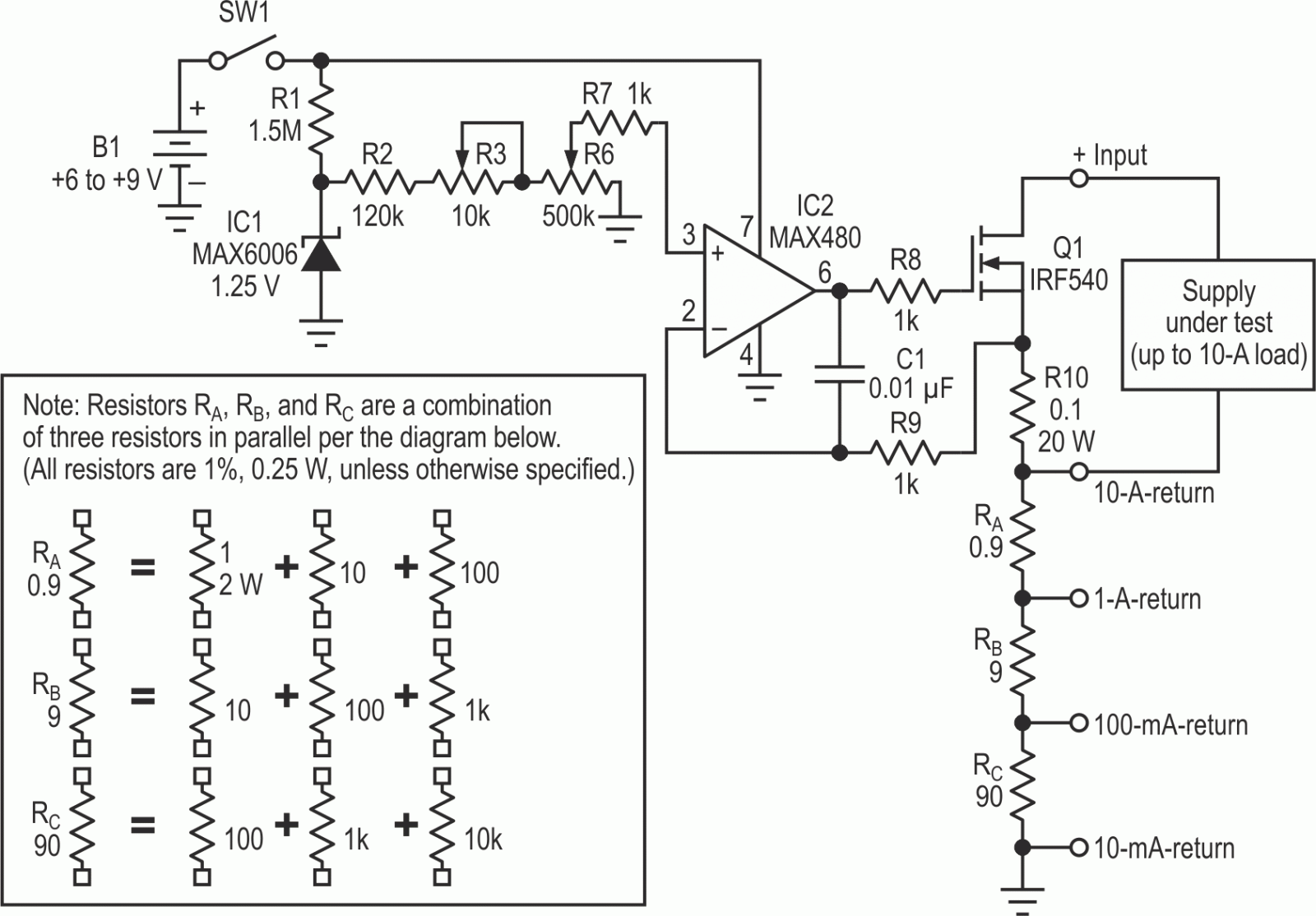This dummy-load circuit has been in use at Maxim for more than 10 years (see the Figure 1). It's useful for testing power supplies and power amplifiers as well as drivers for LEDs, relays, and solenoids. Plus, it overcomes the limitations of power rheostats, which are bulky and have coarse setting accuracy. The device also has an advantage over large, expensive power decade boxes, which provide limited resolution.
 |
|
| Figure 1. | A low-power control circuit in this adjustable dummy load enables the high-resolution potentiometer R6 to precisely control load currents as large as 10 A. |
Unlike conventional resistive loads, the "dummy load" maintains a constant but adjustable load current for voltages in the range of 1.2 to 50 V. Both the power MOSFET and the sense resistor are used to dissipate the load power. Battery operation provides isolation while eliminating grounding problems.
The 10-turn potentiometer R6 affects accuracy and resolution. Consequently, it should be rated for at least 3% absolute accuracy and 0.2% or better linearity. (If desired, R6 can be replaced with a three-digit pushbutton potentiometer such as Bourns model 3680.) R6's wiper provides a reference to the op amp, whose input common-mode range includes ground. Feedback ensures that the wiper voltage appears across the sense resistor (R9), thereby forcing a desired load current through the MOSFET.
Bias current for the op amp (3 nA maximum) flows through the series combination of RA, RB, RC, and R10. Multiplying this current by the sum of the four series resistors (100 Ω) yields a 300-nV error. This error voltage is small compared to the voltage presented by R6 at the op amp's noninverting terminal. Therefore, the resulting output-current error is insignificant. Capacitor C1 enhances stability by reducing bandwidth (already low by this point).
The series-connected, decade-weighted load resistors RA, RB, and RC yield four ranges of output-current capability. To set the range for a power-supply load, connect the positive lead of the supply to the "+" input of the load circuit and the negative load to one of the four return terminals.
For calibration, insert a battery and turn on the circuit. Then, connect the positive terminal of a 5-V/10-A power supply (in series with an ammeter that has a 4.5-digit display or better) to the "+" input of the dummy load. Next, connect the ground terminal of the power supply to the 10-A return of the load box. With R6 at full scale, adjust R3 so the ammeter reads precisely 10.00 A. To check the circuit's linearity, set R6 to exactly five turns and verify that the ammeter reads 5.00 A.
Calibrate the remaining ranges by regulating the values of RA, RB, and RC. Since each of these consists of three resistors in parallel, the value is best adjusted by changing the largest of the three parallel-connected resistors. For example, to regulate RA, set R6 at full scale and adjust the largest of the three resistors in R6 (100 Ω) until the ammeter reads 1.00 A. Then adjust the largest of the RB resistors for a 100-mA reading, and the largest of the RC resistors for a 10-mA reading.
The minimum operating current for the MAX6006 reference is 1 µA, yielding an overall supply current of only 18 µA. Given the 580-mA-hr rating of a 9-V battery, this circuit can operate continuously for several years. With its 15-µA maximum supply current and 25-µV typical offset voltage, the MAX480 is an excellent choice for this application.